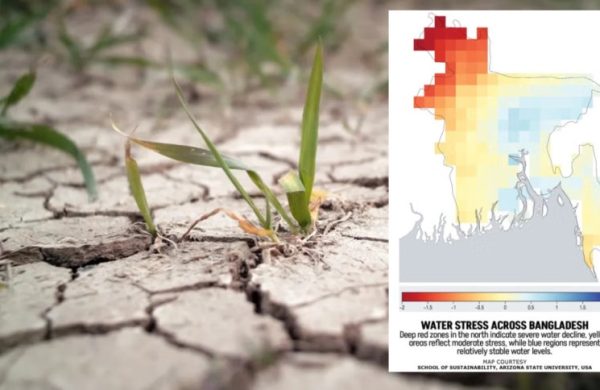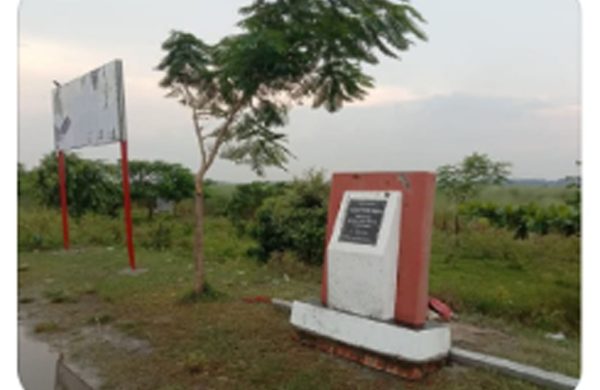Northern region drying up amid freshwater loss
- Update Time : Saturday, September 13, 2025

Staff Correspondent:
Freshwater, both surface and groundwater, from northern Bangladesh has been declining steadily for the past two decades, reveals a new global study.
The research, led by Arizona State University and published in Science Advances, analysed over 20 years of satellite data.
Titled “Unprecedented continental drying, shrinking freshwater availability, and increasing land contributions to sea level rise”, it found that 101 countries in the northern hemisphere have suffered unprecedented freshwater loss since 2002, driven by climate change, unsustainable groundwater use, and extreme droughts.
“Bangladesh is among the countries where freshwater has been declining for over the last two decades. Every year, it is reducing by 2.5mm–10mm. This is very alarming for us,” said Md Rayhan, a Bangladeshi PhD student at Arizona State University who contributed to the study.
Using GRACE/FO satellite data from 2003 to 2024, the study tracked total water storage (TWS) across the Ganges-Brahmaputra Basin, which covers much of Bangladesh. It found a consistent decline over 21 years.
The North-West and North-Central regions appeared in reddish shades on satellite maps, showing annual TWS losses between −1 and −2cm.
“These TWS patterns show that over the past 21 years, parts of Bangladesh within the Ganges-Brahmaputra Basin have experienced long-term declines in water storage.
“This water loss is not just a short-term change, but a long-term trend that has remained consistent even as more data has been added to the study. Scientists call this kind of steady, ongoing change a ‘robust’ trend,” Rayhan said.
“It means the drying pattern in Bangladesh has been strong and consistent, not just due to random weather or short-term events. The study shows that Bangladesh is one of the places in the world where water storage has been going down consistently over the study period.”
As the water level continued to decline, last month, the government announced fifty unions in 26 upazilas of Rajshahi, Chapainawabganj, Naogaon and Chattogram as severely water-stressed. Of the unions, 47 are in Rajshahi, Chapainawabganj, and Naogaon, while three are in Chattogram’s Patiya upazila. The government is working on preparing a guideline to restrict water abuse in those areas.
A GLOBAL CRISIS
The study warns that nearly six billion people in 101 countries — about 75 percent of the global population — have lost freshwater over the past two decades.
Researchers found that 68 percent of land-based water loss came from groundwater alone, contributing more to sea level rise than the Greenland and Antarctic ice sheets combined.
“These findings send perhaps the most alarming message yet about the impact of climate change on our water resources,” said Jay Famiglietti, the study’s principal investigator and a Global Futures Professor at ASU’s School of Sustainability.
“Continents are drying, freshwater availability is shrinking, and sea level rise is accelerating. The consequences of continued groundwater overuse could undermine food and water security for billions of people.”
Lead author Hrishikesh A Chandanpurkar added, “Glaciers and deep groundwater are like ancient trust funds. Instead of using them sparingly during crises such as prolonged droughts, we are depleting them without replenishment, edging towards an imminent freshwater bankruptcy.”
According to the United Nations, by 2030 the world will need at least 30 percent more water, 45 percent more energy, and 50 percent more food.
Climate change is compounding this crisis in Bangladesh, as declining Himalayan meltwater inflows and sea level rise are already causing saltwater intrusion in northern districts, further reducing both surface and groundwater availability.
As a downstream nation, the country also faces a regional disadvantage. Upstream extraction in India and Nepal continues to affect flows, yet no effective cross-border water-sharing agreements exist. This imbalance worsens seasonal stress across the country.
GROUNDWATER EXTRACTION
The country extracts about 32 cubic kilometres of groundwater every year, 90 percent of which is used for irrigation and 10 percent for domestic or industrial use.
“Due to such over-extraction, groundwater is being contaminated with salt and heavy metals. Twenty-four percent of lands are now exposed to extremely elevated arsenic, salinity and groundwater depletion hazards,” said Dr Anwar Zahid, former director of groundwater hydrology at the Bangladesh Water Development Board.
“We’ve observed that groundwater levels in urban areas, particularly Dhaka and the Barind Tract, have been declining permanently at an alarming rate. This implies that the water level is not being recharged even after monsoon. With increased extraction, fluctuation of groundwater levels has also increased with time.”
A 2019 study found Bangladesh losing groundwater at an average rate of 8.73 millimetres per year. In 2006, the number of shallow pumps was 11.8 lakh; by 2019, it had risen to 16 lakh. Dhaka Wasa alone pumps about 3.3 million cubic metres of water every day — enough to fill 20 Mirpur stadiums.
For families in Dhaka, tube wells are increasingly unreliable, forcing many to rely on costly water deliveries.
In Keraniganj, villagers face water scarcity for months. “From March to June, we get no water,” said resident Akhil Chandra Das.
Farmers also struggle. “All the farmers use groundwater to irrigate their paddy field because it is cheaper than surface water. To irrigate one bigha [33 decimals] of boro, it takes Tk 3,000 for a season. But to irrigate with surface water, we need to hire day labourers or install shallow machines which are even costlier,” said Shimul Ali, a farmer from Rajshahi’s Paba upazila.
“However, since it rained a lot this year, we didn’t need to irrigate our fields.”
Meanwhile, coastal villagers face salinity intrusion in drinking water, leaving them dependent on rainwater harvesting or unsafe sources.
DRAWBACKS AND SOLUTIONS
“The population is increasing every year, and so is the demand for freshwater, particularly for irrigation and industry. Naturally, our natural water storage is shrinking day by day,” Dr Zahid told journalists.
He stressed the need to shift towards surface water and rainwater retention.
Large-scale rainwater harvesting has not materialised, while chronic urban waterlogging prevents effective recharge. Experts warn that without urgent updates and enforcement, water governance will remain inadequate.
A 2023 global study published in Nature and supported by NASA’s GRACE satellite data shows Bangladesh losing significant amounts of freshwater annually.
According to the World Bank (2021), groundwater levels in parts of Dhaka are dropping by nearly 2–3 metres every year, threatening long-term water security.
This crisis is further compounded by salinity intrusion in coastal regions and reduced dry-season flows of major rivers such as the Ganges, Brahmaputra, and Meghna.
“Without urgent interventions in sustainable water management, Bangladesh’s freshwater decline could severely impact agriculture, public health, and overall resilience to climate change,” warned urban planning expert Ahmed Mukta.












